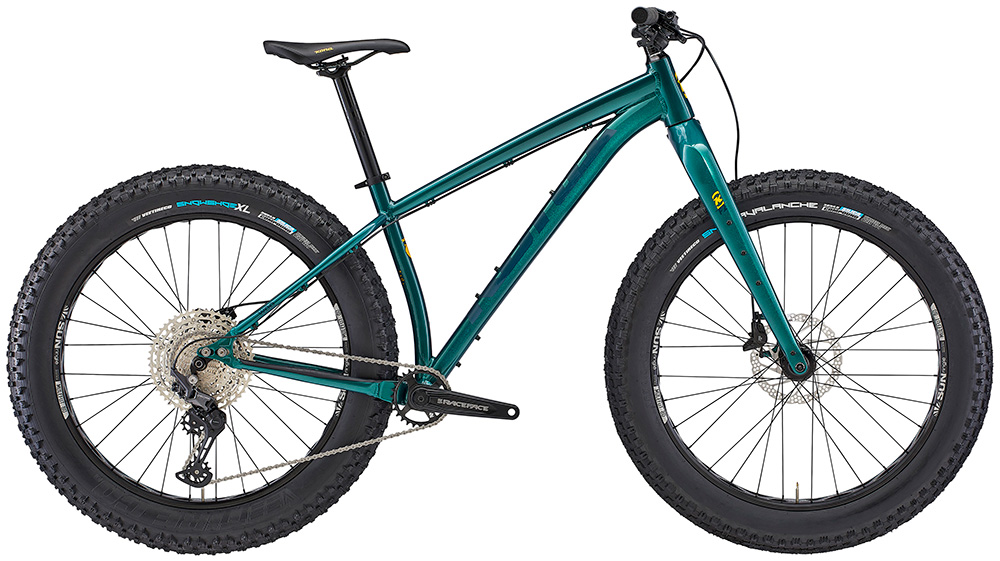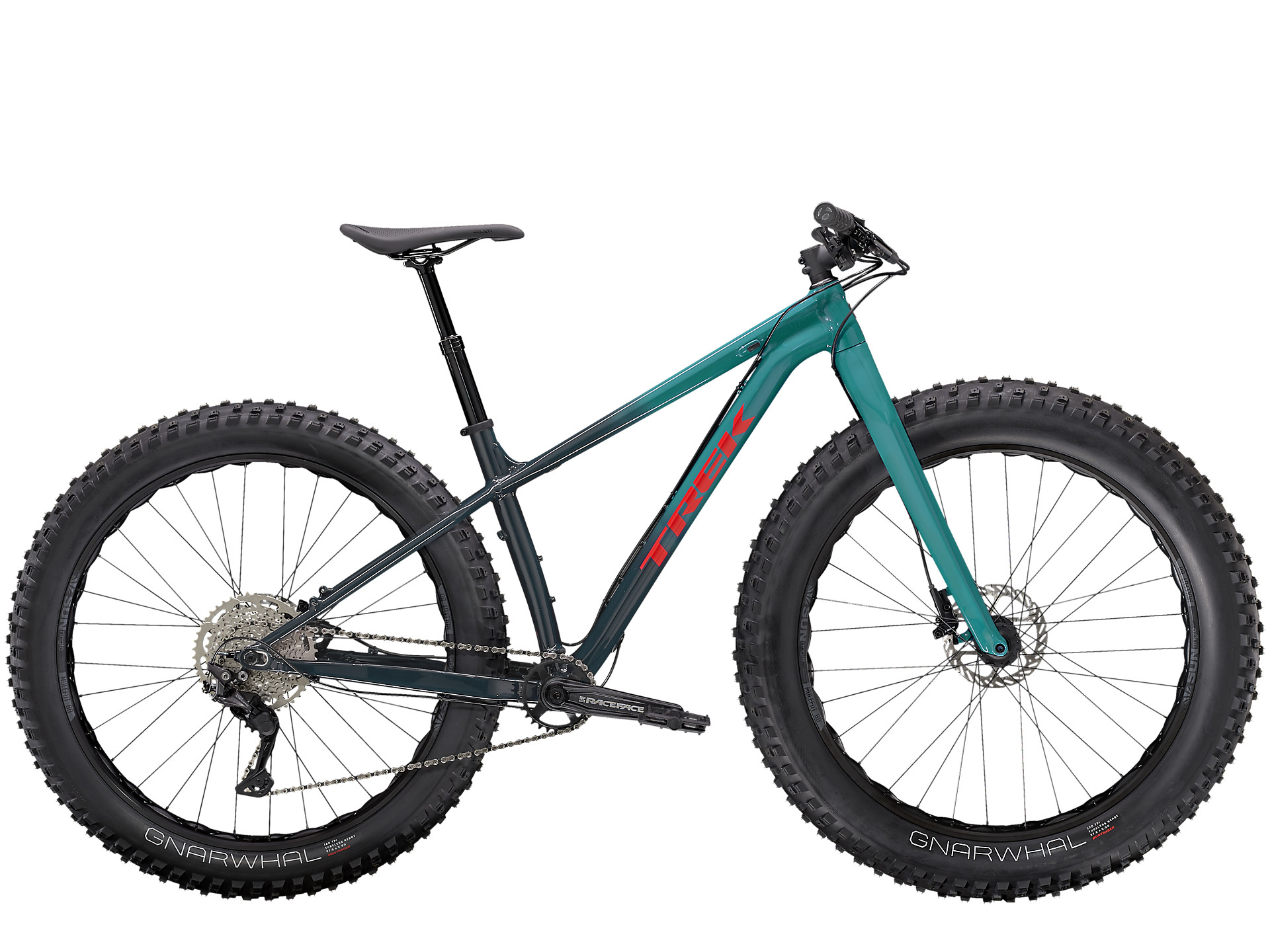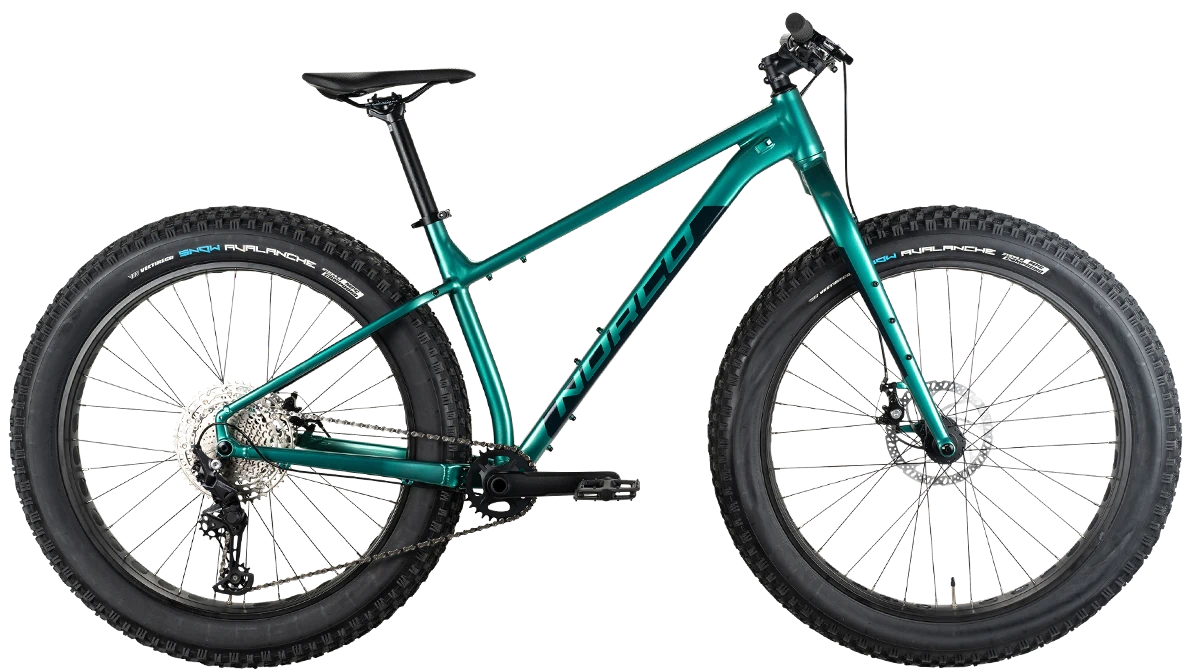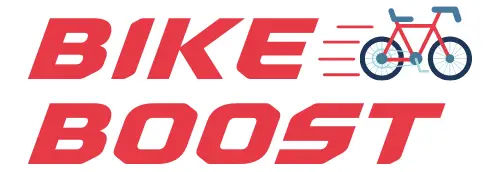We love writing these guides for you and sometimes we are compensated when you use one of our links to buy a product. This doesn’t impact the final price you pay. If you want to learn more about how this works, please see our Affiliate Disclosure page.
There are many different types of bicycles available on the market these days and it can be difficult to decide which one is right for you. If you’re looking for a bike that’s perfect for touring, then a fat tire bike may be the best option for you. Fat tire bikes have large, thick tires that provide plenty of cushioning and stability, making them ideal for traversing rough terrain. They’re also relatively lightweight and easy to manoeuvre, which makes fat bikes perfect for long distances.
Whether you call it Bikepacking or Touring, fat bikes are definitely the way to go and in this guide, I will share the 4 best fat tire bikes for touring.
Fat Bikes in This Guide

Kona Woo

Trek Farley 5

Salsa Mukluk Advent X

Norco Bigfoot 3
How to Choose a Fat Tire Bike for Touring
Fat Bike Frame Material
When choosing a bicycle, the frame material is one of the most important factors to consider. The frame material will affect the weight and durability of your bike, so you’ll want to choose something that will fit your needs.
Bikes can be made from different materials, like steel, aluminum, and carbon fibre. Each material has its own unique attributes that make it good for different things. Make sure to consider the pros and cons of each material before making your purchase! Choosing the perfect frame is a matter of finding the right balance between price, durability, and weight. You want to find something that is affordable, yet tough enough to last.
Steel Frame Fat Bikes
Are you looking for a bike that is both sturdy and available for all skill levels? Look no further than the steel-frame bicycle! This popular option is perfect for those purchasing their first bike.
Bicycle frames made of steel are the heaviest material you can use when building your bike! But don’t worry, they’re still really strong and durable!
Steel-framed bikes are generally cheaper and more affordable than other types of bike frames. In fact, budget-priced steel bikes are always composed of steel.
Aluminum Frame Fat Bikes
Aluminum is a lightweight metal that has been used in bike frame making for many years! It’s a great material because it’s durable and easy to work with. They’re also lighter and more eco-friendly than classic-steel frames. Plus, who doesn’t want to save a little weight?
Aluminium frames are usually made of a mix of different metals, such as magnesium, copper and zinc. This makes them strong and versatile for all kinds of purposes.
Aluminum bikes are amazing! Not only are they lightweight and perfect for versatile rides, but they’re also great for mountain biking competitions!
Bikes made from aluminum can cost a little bit more than steel-framed bikes, with the entry-level models costing around the same amount as a mid-range steel-framed bike.
These bikes are built to last and can handle any terrain, so they’re perfect for off-road riders!
Carbon Frame Fat Bikes
Carbon frames are SUPER expensive because carbon is like the Rolls Royce of bike frame materials! Alu and steel frames are like low-rent bikes compared to a carbon frame!
Carbon fibre is a super-strong material, so it’s often used with a resin to create a very strong composite material. This process is then used to create a variety of materials that may be shaped into the desired form for use in bike frames, electronics casings, and even medical applications.
Carbon frames are popular among mountain bikers because they’re so light and strong. These frame materials are incredibly tough and strong, making them perfect for mountain biking on rough terrain.
One of the issues with carbon fibre frames is that it can be difficult to see if there is a weakness in the material. If the crash were to happen, you wouldn’t be able to tell if the material is good or not without heading out on a ride and finding out the hard way. You won’t know if the tubing will break under stress until you try it!
Fat Bike Components
Bikes are much more than just frames and wheels! They come with all sorts of other important components, like handlebars, brakes, gears, and drivetrains. The frame and wheels are the most important parts of a bike, and most people are willing to spend a lot of money on them!
A fat bike that’s perfect for you fits your needs and has components that are durable! It is so important to research the bike’s warranty coverage, as well as other great details!
Below are some of the components that you might think about changing in order to improve your fat bike:
- Gears/Drivetrain – How much flexibility do you require for off-road and uphill mountain biking? If you answer with a great deal of flexibility, we recommend that you go with a huge number of gears. If you answer with just a few gears, we recommend that your gears just have the ability to travel on flat roads.
- Brakes – Do you want an easy-to-maintain option, such as V-brakes, or is it more important for you to engage in a more reliable option, such as disc brake systems?
- Handlebars – Do you want a flatter handlebar for more classic style or a curved handlebars for more options regarding your hand position while riding?
Tire and Wheel Size
When shopping for fat bike tires, make sure to look at the height and width of the tires and wheels! This is an important step in ensuring you get the perfect fit for your new fat bike tires.
Tire Size
When choosing fat bike tires, many people naturally consider the width. Did you know that the term “fat” tires comes from the fact that they are generally wider than 3.8 inches? The widest fat tires you can get are over 5 inches wide!
Most cheaper fat bikes come with 4 inch wide fat tires. More expensive versions can go up to 4.8 inches! This makes them perfect for off-road biking and other outdoor activities!
Have you ever ridden a bike with skinny tires? It’s not as much fun as riding one with wider tires! The width of your tires affects how your bike rides on different surfaces.
Wider tires mean more rolling resistance which slows you down on flat surfaces. Your fat bike will feel sluggish on these surfaces compared to bikes with narrower tires. Tires with a larger diameter are generally more difficult to roll on flatter terrain, like those often seen in densely populated urban areas.
Wider tires are great for riding on looser surfaces, like snow and sand. With the extra surface area, you can spread your weight and ride across the top of the surface.
Wider tires are generally a better option for rough terrain. If you’re looking for a bike that will perform well on paved routes, you’ll want to choose one with narrower tires! They’ll give you a smoother ride and better overall performance. If you’re looking for a bike that can handle rougher terrain, consider opting for wider tires that are at least 4.8 inches wide!
Wheel Size
The diameter of the wheel is the distance from one side to the other inside the rim.
The size of the wheel on your bike can make a huge difference in how comfortable and enjoyable your cycling experience is. Be sure to choose the wheel size that’s perfect for your needs. Whether you’re a leisurely rider or a speed demon, there’s a bike and wheel size out there for you.
Most of these bikes will feature a 26-inch wheel size, which is the most popular size for riders of fat bikes! This wheel size has been proven to be perfect for riders who want an exciting, adventurous experience on their bike. Most adults will be able to find the riding position that’s most comfortable for them with this wheel size. If you’re taller or shorter than this height range, you may need to adjust the seat and handlebars on your bicycle to ensure a comfortable ride!
If you’re 5′ or shorter, there are tons of great wheel size options for you. For shorter riders, a 24-inch wheel is perfect. There’s a wide range of bike sizes available, but for taller people, 27.5-inch bikes are pretty common. Some manufacturers even produce bikes with 29-inch wheels!
Bike Weight
Another thing to think about when selecting your fat bike is how much it weighs! A heavier bike can be harder to pedal, so you’ll want to consider that when making your decision.
A heavy bicycle may feel strong and sturdy, but that very simplicity can be a downfall because of two major disadvantages.
Heavier bikes are not just difficult to move around when riding compared to lighter bikes, but they can also be difficult for storage as well as lifting them for storage in your garage is more difficult.
The harder your bike gets, the more difficult it will be to control up hills. If you’re planning to do some hardcore mountain biking on your fat bike, opt for a lighter model so it won’t feel quite as sluggish when going uphill! When climbing a mountain, the weight of your body can actually pull you back down!
Fat bikes are great for downhill riding! When your wheels are larger, it’s easier to stay on top of the terrain and maintain control. Use the power of gravity to your advantage and have a blast!
Best Fat Tire Bikes For Touring
Kona Woo Fat Bike

Key Features:
- Frame = Aluminum
- Gears = 12 Gears
- Brakes = Hydraulic Disc brakes
- Wheel Size = 26” x 4.8”
- Weight = Unknown
The Kona Woo has been designed with the bikepacker in mind, offering plenty of anchor points for you to attach various bags of gear.
Made from a Kona Fat 6061 Aluminium Butted material, the frame is light and strong, making it great for off-road rides as well as commutes.
The Woo comes with 12 speeds, based around a Shimano Deore 11-51t set of cogs. Coupled with the 28t Ride Wide Narrow chainring, you get plenty of gears to work with, whether you are hitting the trails of the pavements.
The Shimano M4100 Hydraulic Disc Brakes give you excellent stopping power when you need it.
The wheels are based on 26-inch tubeless-ready rims, with a Vee Tire Snow Avalanche 4.8-inch tire on the front and Vee Tire Snowshoe XL 4.8-inch tires on the back. This gives you a wide wheelbase for taking your bike out in the snow and taking on pretty much any weather that can be thrown at you.
Trek Farley 5 Fat Bike

Key Features:
- Frame = Aluminum Alloy
- Gears = 10 Gears
- Brakes = Mechanical Disc brakes
- Wheel Size = 27.5” x 4.5”
- Weight = 33 lbs
The Trek Farley 5 is one of three awesome fat bikes offered by Trek, a brand synonymous with quality bikes.
The Farley 5 is the cheapest of the Farley range, just squeaking under the $2000 mark.
This aluminum framed fat bike weighs just 33 pounds, making it the lightest fat bike on this list. If you are wanting to save yourself a couple of pounds on your fat bike weight, this would be a good choice for you.
For gears, you get a Shimano Deore M4100 11-46t, 10-speed cassette, giving you a range of gears on par with other bikes in this price range. This is coupled with a Race Face Ride 28T steel ring crank, which is smaller than most on this list. This means you will have slightly smaller gearing than other bikes giving you more control at lower speeds, which is great for technical sections of riding.
It is also equipped with Avid G2 CleanSweep Mechanical Disc Brakes, meaning you can slow down with ease when needed.
For wheels, you get 27.5-inch rims, fitted with 4.5-inch wide Bantrager Gnarwhal tires. These are very durable tires, with a TPI of 120. This is very high compared to other bikes, meaning you have very durable tires which are less likely to puncture.
Salsa Mukluk Advent X Fat-Tire Bike

Key Features:
- Frame = Aluminum Alloy
- Gears = 10 Gears
- Brakes = Hydraulic Disc brakes
- Wheel Size = 26” x 4.6”
- Weight = Unknown
The Salsa Mukluk Advent x Fat Tire Bike is a top-end fat bike at a really good price.
This fat bike has been designed using 6000-series aluminum, which is designed to be strong without creating too much weight. This will make it much easier to take this bike off-road and have fun without getting too tired lugging a heavy bike around with you.
The Salsa Mukluk features MicroSHIFT CS-H104 11-48T rear cogs, with a Samox Direct Mount 30T from chainring. This means you get 10 gears for taking your bike off-road or just riding through the streets nearby.
This bike also comes with Tektro HD-M275 hydraulic disc brakes, which will give you plenty of stopping power, even when heading downhill fast.
In terms of wheels, this bike comes with 26-inch rims, which feature 4.6-inch 45NRTH Dillinger 5 Tubeless-ready tires. This gives you a great amount of width for balance as well as some high-quality tires to ride on.
Norco Bigfoot 3 Fat Bike

Key Features:
- Frame = Aluminum Alloy
- Gears = 11 Gears
- Brakes = Mechanical Disc brakes
- Wheel Size = 27.5” x 4.5”
- Weight = 34 lbs
The Norco Bigfoot 3 is the cheapest of the Norco Fat Bikes, just squeaking under the $2,000 price mark.
For your money, you get a butted X6 aluminum alloy frame, which provides strength whilst also keeping the weight down to just 34 pounds. This means you won’t feel like you are being held back by the weight of the bike when riding compared to some heavier bikes on the market.
This fat bike comes with a Shimano Deore CS-M5100 rear cassette, with 11/51T cogs providing 11 speeds. This is connected to a Samox Alloy 30T crankset, giving you a solid range of gears for powering this bike.
For braking, the bike has Tektro MD-280 mechanical disc brakes on the front and the back. Whilst these aren’t hydraulic brakes, which are known for providing more stopping power, the easier maintenance can be a big plus.
The rims on this bike are 27.5 inches and are fitted with 4.5 inch Vee Snow Avalanche Studdable tires. This makes this bike great for speeding through the snow, due to the large rims delivering more distance with every rotation of the wheel.
Summary
In conclusion, when looking for the best fat tire bike for touring, it is important to consider the different features that each bike has to offer. One of the best bikes on the market for touring is the Kona Woo. It has a durable frame, plenty of storage space, and a comfortable ride.
Andy is an avid cyclist who enjoys nothing more than a ride out in the hills. Competing in track, road, time trial and mountain bike events in the past, he prefers slower rides out with his family these days.
